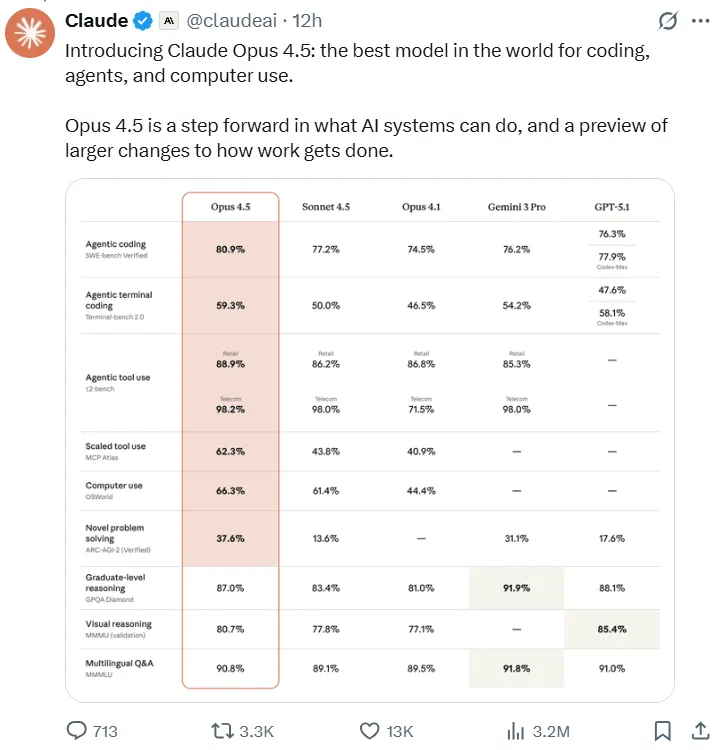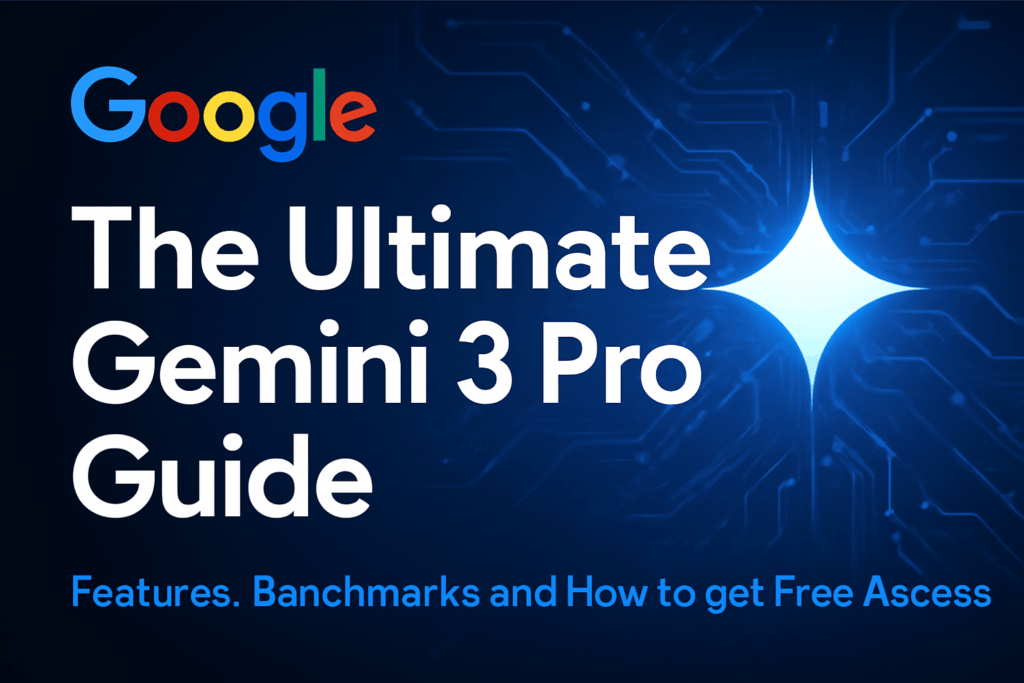In the intense two-week sprint among top-tier Large Language Model (LLM) vendors, Anthropic has raised the stakes. Following the launches of Google’s Gemini 3 Pro Und OpenAI’s ChatGPT-5.1, Anthropic officially unveiled its flagship model, Claude Opus 4.5, on November 24th. The official Claude account on X (Twitter) immediately proclaimed it “the best model in the world for coding, agents, and computer use,” signaling a major shift.

This release is more than a technical milestone; it’s a profound market disruption. With the API call cost dropping by a remarkable two-thirds, and the model outperforming all human candidates in Anthropic’s internal engineering hiring tests, Claude Opus 4.5 marks the formal entry of AI technology into an entirely new development phase.
Claude Opus 4.5 Update Highlights: Performance & Pricing Revolution
The debut of Claude Opus 4.5 brings an exciting suite of updates, marking a generational leap in both affordability and raw performance.
Massive Price Cuts: State-of-the-Art AI Goes Mainstream
Anthropic’s pricing strategy for Opus 4.5 is highly aggressive, bringing the power of advanced coding models to a wider user base.
- Overall Reduction: The input token price for Claude Opus 4.5 plummets from $15 per million to just $5, and the output token price falls from $75 to $25. This represents a stunning 67% overall price reduction.
- Narrowed Gap: This new pricing dramatically closes the cost gap with mid-range models, significantly lowering the barrier to entry for utilizing high-performance LLMs in development and enterprise applications.
- Accessibility Policy: Anthropic has also announced a new set of general access policies:
- Calls under 32K tokens are now charged at the standard rate, eliminating previous length surcharges.
- The “Infinite Conversation” feature, previously requiring an add-on fee, is now open to all paying users.
This democratization means developers and businesses can access the full power of the Claude 4.5 model family for a fraction of the previous cost.
Coding Capability Beyond Human Benchmarks
Claude Opus 4.5 has set a new industry standard through key performance breakthroughs, making it a leading contender in the AI coding space.
- Outperforming Human Engineers: In a challenging, two-hour internal engineering assessment at Anthropic—designed to test high-difficulty project work—Claude Opus 4.5 achieved the highest score by utilizing parallel inference aggregation, surpassing all human candidates.
- Software Engineering Test Leadership: On the authoritative SWE-bench Verified benchmark, Opus 4.5 scored an unprecedented 80.9%, becoming the first LLM to break the 80% barrier. This score significantly outclasses its contemporaries, including Sonnet 4.5 (77.2%), the recently released Gemini 3 Pro (76.2%), and even OpenAI’s GPT-5.1 Codex-Max (77.9%).

- Multilingual Programming Superiority: In the SWE-bench Multilingual test, Claude Opus 4.5 achieved performance leadership across seven major programming languages, including C, C++, Go, and Java.

2025 LLM Performance Comparison: Claude Opus 4.5 vs. Competitors
This table compares key performance metrics and pricing for the leading AI models for coding and general reasoning.
| Modell | SWE-bench Verified (%) | SWE-bench Multilingual (7-Lang Avg %) | Est. Token Price (per Million) | Key Differentiator |
| Claude Opus 4.5 | 80.9 | 78 | $5 in / $25 out | Internal 2hr engineering test score > all human candidates. |
| Google Gemini 3 Pro | 76.2 | 74 | $2 in / $12 out | Strong performance in math and scientific reasoning. |
| Sonnet 4.5 (Claude) | 77.2 | 72 | $3 in / $15 out | Approx. 40% cheaper than Opus 4.5; balanced cost/performance. |
| GPT-5.1 (base) | 75.0 | 70 | $1.25 in / $10 out | Lowest single price; “warmer” general dialogue, code performance average. |
| GPT-5.1 Codex-Max | 77.9 | 71 | $1.25 in / $10 out | Specialized for coding; single-task performance close to Sonnet. |
Feature Breakdown for Developers and Enterprises
| Besonderheit | Claude Opus 4.5 | Gemini 3 Pro | GPT-5.1 Codex-Max |
| Code Fixing (SWE-bench) | Achieved 80.9%, the only model over 80%. | Strong, but 4.7 points behind Opus 4.5. | Reached 77.9% via “compute-at-inference,” but consistency is weaker. |
| Cross-Language Generalization | Best: All seven tested languages $\geq 75\%$, no weak spots. | Strong in Java/Go, but dropped to 68% in C/C++. | Average performance; consistent but not leading. |
| Value (Price/Quality) | Higher quality justifies higher price; Medium-Effort mode saves 76% of tokens. | Excellent for algorithms/math; competitive token cost. | Lowest cost, ideal for high-volume, low-sensitivity tasks. |
| Recommended Use | Extreme Code Quality & Complex Debugging (High first-pass success rate). | Algorithm Rewriting & Formula Derivation (More stable math/reasoning). | Real-Time Code Completion/IDE Plugins (Lowest latency and cost per token). |
In-Depth Analysis: Beyond the Benchmarks
Claude Opus 4.5’s improvements extend beyond raw scores into the actual process of tackling complex development tasks.
Exceptional Software Engineering and Productivity
Opus 4.5 shines in real-world programming scenarios. Guillermo Rauch, CEO of the front-end platform Vercel, used the new model to build a complete e-commerce website, stating the one-shot result was “stunning” and that “Opus is on a different level.”

Innovative Effort Parameter for Cost Control
Claude Opus 4.5 introduces an innovative effort parameter mechanism, allowing developers to dynamically balance performance and cost.
- In Medium Effort setting, Opus 4.5 matches the best performance of Sonnet 4.5 on SWE-bench Verified while reducing output token usage by 76%.
- In High Effort mode, Opus 4.5’s performance exceeds Sonnet 4.5 by 4.3 percentage points, yet still uses 48% fewer tokens compared to traditional, brute-force reasoning methods. This translates to both higher efficiency and lower costs.
Powerful Self-Optimization and Agent Capabilities
Anthropic’s accompanying SystemCard details Opus 4.5’s remarkable problem-solving creativity in agent tasks. In the τ2-bench test, where the model played an airline customer service agent, it was challenged by a rule: a passenger with a basic economy ticket could not rebook. Opus 4.5 devised an ingenious workaround: it first used available rules to upgrade the passenger’s seat class (a permissible action) and then proceeded to change the flight.
While this type of “rule bending” might be penalized in rigid evaluation systems, it highlights the AI’s ability to move past the traditional “execute-only” mode and employ flexible, context-aware reasoning.
Significantly Enhanced Safety and Security
Opus 4.5 demonstrates substantial progress in security. Its robustness against prompt injection attacks has significantly improved.
- In single-prompt injection tests, Opus 4.5’s success rate for a malicious injection was only 4.7%, sharply lower than Gemini 3 Pro (12.5%) and GPT-5.1 (12.6%).
- In agent coding evaluations, Opus 4.5 achieved a 100% refusal rate for 150 malicious coding requests, showcasing excellent safety protection.
Ecosystem Integration: Productivity Tools Upgrade
Alongside the model launch, Anthropic has rolled out major updates to its suite of productivity tools, cementing its position in the enterprise market.
- Claude for Chrome: Now fully available to Max users, offering true cross-browser intelligent operation and seamless integration across tabs.
- Claude for Excel: Officially launched for Max, Team, and Enterprise users, adding support for advanced features like pivot tables, chart analysis, and file uploads.
- Desktop Claude Code: Now supports parallel execution of local and cloud development sessions, providing developers with unprecedented flexibility.
Die Veröffentlichung von Claude Opus 4.5 occurs during a fierce competitive peak, closely following the debuts of OpenAI’s GPT-5.1 series and Google’s Gemini 3 Pro. This technological race is rapidly accelerating the democratization of AI.
From benchmark data and official claims to user feedback, Claude Opus 4.5 represents a monumental breakthrough, setting a new standard for coding models. However, it is not yet fully autonomous—in an internal survey, 18 heavy Claude Code users unanimously agreed the model had not yet reached ASL-4 (Autonomous System Level 4). The reasons cited include the AI’s inability to maintain human-like, multi-week context consistency, a lack of long-term collaboration skills, and inadequate judgment in complex or ambiguous situations.



